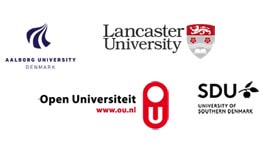

Affording Opportunities to Learn in Homework Online
Nina Bonderup Dohn, Department of Design and Communication, University of Southern Denmark (SDU). Kirsten Lund, Natural History Museum Aarhus. Pernille Holm Lindhardt, State and University Library. Hanne Skipper, Degnebolig,Department of Design and Communication, University of Southern Denmark (SDU)
In this paper we report our research into the learning opportunities created (and obstructed) for students in upper secondary education in Denmark through connecting with voluntary homework tutors on the online platform Homework Online (HO). The platform offers an integrated array of synchronic communication tools, comprising chat, video, audio, whiteboard and access to websites, including Google Docs shared between student and tutor. We utilize Harré and van Langenhove's positioning theory and Greeno's learning theoretical development thereof to analyse the interaction between tutors and students. Our research questions are 1) How are students positioned in particular interactions on HO and how does this contribute to the opening and closing of their opportunities to learn (OTL)? 2) How do the different affordances of HO's communication tools affect the positioning process? We identify the primary communication channels as chat and audio, respectively. We find an overall tendency for tutors and students in collaboration to position themselves within a storyline of teacher-student-interaction, but this storyline of teacher-student-interaction plays out in different ways, as 'teacher-explaining-to-student', positioning the student as recipient, and as 'student-prompted-by-teacher-to-think', positioning the student with agency. The latter opens OTL for the student in the form of engaging in the conceptual and disciplinary practices of the curricular subject, i.e. of developing active conceptual understanding as well as necessary disciplinary skills. The former at most opens OTL in the form of 'legitimate peripheral observation' of such practices, but closes the OTL of active participation in them and thereby also the chance (in this situation) of developing active curricular understanding and skills. Our data show that the different affordances of audio and chat do not lead to fundamental differences in basic positioning patterns and evolving storylines, but that audio affords positioning to conceptual agency better than chat. Similarly, the auditory channel affords active dialogue and supports interpretation of interaction much better than chat does. Still our data show that more important than the difference between chat and audio for the positioning of the student as accountable versus as to-be-explained-to is the use made of the whiteboard, especially the question whether the student, the tutor, or both in interaction are in charge of writing on it.
Keywords
Online tutoring, positioning, conceptual and disciplinary agency, Greeno, upper secondary education
Joint Organising Institutions
| Past Conference Proceedings |Call for Book Proposals| Contact |